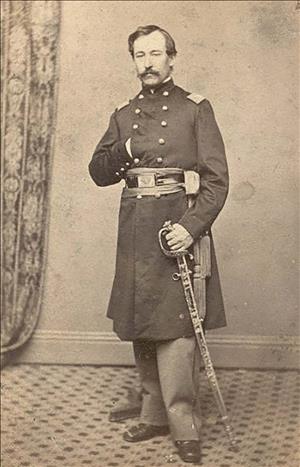On June 12, 1903, Fort Ward on Bainbridge Island is officially named. The fort is a United States Army coastal defense post constructed to protect the Bremerton naval shipyard. It will be an active installation until the 1920s. It closes in 1928, and become a summer camp for needy boys and girls. In 1938 the navy takes it over as a recreational camp for sailors. In 1939 the post becomes a secret navy listening post (Station S) for intercepting Japan's military messages, and also helps track enemy shipping. In addition, a Naval Reserve Radio School operates there from 1940 to 1953. In 1953 the navy closes Fort Ward, and in 1960 the waterfront area becomes Fort Ward State Park (now Fort Ward Park, part of the Bainbridge Island Metro Park & Recreration District).
Guns at Beans Point
On February 1, 1900, construction began on facilities to protect the Bremerton naval shipyard. Coast artillery experts planned five gun batteries (four were built), along with Puget Sound minefields, including a gun installation at Beans Point, Bainbridge Island. This installation was officially named Fort Ward on June 12, 1903, in honor of Brigadier General George H. Ward (1826-1863), 15th Massachusetts Volunteer Infantry. Ward died on July 2, 1863, from wounds suffered in the Civil War battle at Gettysburg.
Fort Ward's four named gun batteries honored soldiers who had served with valor. Battery Nash, the main battery, had the largest coastal defense artillery, three eight-inch guns. This battery honored Brigadier General Francis Nash (1742-1777), who was mortally wounded in the Battle of Germantown during the War for Independence. Tennessee named a city after him, but he had no connection to Bainbridge Island or Washington. The remaining batteries had smaller rapid-fire guns to defend minefields. Battery Warner, named for Captain William Warner (d. 1849), killed by Indians while surveying in California, had two five-inch guns. Battery Vinton, named for Major John Vinton (1801-1847), killed at Vera Cruz, Mexico, contained two three-inch guns. Major Thomas T. Thornburgh (1843-1879) had a gun battery named to honor his valor in the Indian Wars. He was killed in action at Milk River, Colorado.
Fort Ward included 24 buildings, which served as officer and NCO housing, barracks, administration, a guardhouse, bakery, quartermaster and commissary building, mine facilities, shops, and warehouses. Brick construction dominated, despite the abundant lumber available. The bricks were obtained from nearby sources, making the construction cost effective. Reinforced concrete was used to build the gun batteries, which were completed in 1903. Three years later, shipping lanes in Puget Sound were mined. During World War I, the fort had a torpedo test area. A minefield with beer barrels loaded with dynamite was considered but not installed.
By the 1920s, Fort Ward was largely inactive. Gun batteries were removed in 1920, and the fort officially closed on March 12, 1928. The two soldiers who had remained to guard the abandoned post were removed in 1933, emptying the place.
Fort Ward Summer Camps
In the summer of 1935 the American Legion joint child welfare committee, Washington Department, organized summer camps for boys and girls. The summer camps at Fort Ward were for children on the King County relief rolls. They would be the first of their kind in the nation. The American Legion provided camp furnishing and supplies. The 10 weeks of camp were divided into five weeks each for boys and girls. Five hundred children, selected by King County Relief, attended the camp.
The Washington Emergency Relief Administration provided the food. Camp recreation directors came from local universities and the state Department of Health assigned a doctor and three nurses. Every child received a physical before departing for camp. The camp served as part of a wellness program for needy children. Children received health care plus recreational time in the outdoors.
In July 1937, sailors off the battleship USS Arizona spent recreation time at the old fort. A year later, the U.S. Navy took it over as a recreation camp offering personnel relaxing time in a country setting. Surrounded by farms and a peaceful natural setting, Fort Ward provided welcome relief from shipboard duty.
Navy Listening Post
In September 1939 the navy opened a listening post at Fort Ward called Communications Support Activities (COMSUPACT). Rhombic antennas were erected on the parade grounds for receiving signals, while an 800-foot-tall antenna for transmitting was built at Battle Point, about eight miles away on the west side of the island. In 1940, the Fort Ward facility was renamed Station S, Naval Security Group Activities (NSGA), and eavesdropped on the Tokyo-to-San Francisco radio net, recording Japanese diplomatic messages sent in Japanese Morse code.
Fort Ward was designated a Naval Radio Station. During World War II, the post tracked enemy vessels through radio direction finding (RDF). Using radio signals acquired by several listening stations, RDF could identify a ship’s location. Bainbridge operated in the West Coast High Frequency Direction Net as the Net Control and Plotting Center, compiling its own and other RDF stations’ data to keep a log of Japanese ship locations. The data was then sent to West Coast naval commands and the Chief of Naval Operations in Washington, D.C.
After the war the listening post turned its attention to Korea and the Soviet Union.
Fort Ward State Park
In 1958 the United States Navy withdrew from Bainbridge Island. In 1959 the General Services Administration disposed of the land and buildings. In 1960, 137 acres on the water became Fort Ward State Park. In 1978 the Fort Ward site was listed on the National Register of Historic Places. The park now operates as Fort Ward Park, part of the Bainbridge Island Metro Park & Recreation District.

